CONSTELLATION GUIDE
Last updated: 4 August 2001
CONSTELLATION GUIDE |
"GO TO"....ARIES
....On the Horns of A Mighty Ram Leading the Zodiacal Herd
** (With a Bonus Listing of Beautiful and Challenging Double and Multiple Stars!) **
From: sherrodc@ipa.net (Clay Sherrod)
This is the 24th Constellation Guide, "GO TO ARIES" of the series "GO TO GUIDES for the ETX, LX 90 and all GO TO Telescope Users. An important "astrological" constellation, Aries represents the FIRST SIGN of the ZODIAC (see the astrological circle shown below), a heavenly Ram that is nearly buried among brighter constellations.
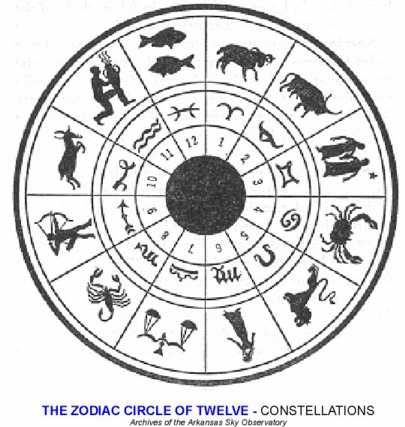
Because of annual precession (the relative positions of celestial objects as we see them changing from Earth due our annual motion of the solar system as the sun moves through the Milky Way as well as the Earth's changing orientation on its axis), Aries is now located beginning at astronomical hour angle roughly 1 hour and 45 minutes, and extends to about 3 hours 30 minutes of Right Ascension. It is so small that it seems almost intentionally "tucked" exactly between declination lines of +10 and +30 degrees.
Although the "number one" zodiacal constellation, this is a very minor area of the sky in terms of bright showcase objects, Messier objects and bright stars. Indeed, it is not even FIRST in the alphabet, being the sixth constellation in that order. Like other constellations that have been discussed in these "GO TO" TOURS of our constellations, Aries is conspicuously absent of: any star brighter than magnitude 2.0; any Messier Object; globular clusters, galactic clusters, planetary nebulae, diffuse nebulae.
The only thing really going for this "RAM" of a constellation is that the ECLIPTIC - the imaginary band in which the sun, moon and planets appear to traverse as we watch them from Earth - pass from the southwest corner to nearly the middle of the eastern side of the constellation.
Indeed, there are ONLY seven NGC objects - all galaxies - that are even distinct enough to view in common (yet large) amateur telescopes. There are two (2) diffuse nebulae....VERY small, but bright enough to be seen in a telescope....that are not even numbered on the NGC catalog: one at 03h 23m / + 30 46 and the other at 03h 25m / + 29 39 (9.0 and 9.3 magnitudes and 4' and 11' arc in diameter, respectively). These are very difficult to spot, in spite of their sizes.
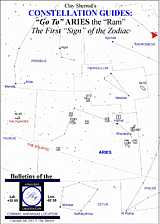
There are, however, some very beautiful double stars in Aries and those are the focus of this GO TO guide to this constellation for the most part.
It is not just in modern telescopic times that Aries has been a largely ignored chunk of sky. Even the star cataloger Bode rather "skipped over" the mighty RAM when he compiled his beautifully-illustrated 19th century star atlas. Look at the sample below, which shows the grandeur of Perseus and Andromeda....even the lowly TRIANGLE of Triangulum. But WHERE is Aries the Ram? Not shown. But Bode did, nonetheless, bother to at least "label" the constellation by name if you look hard enough. I have drawn in the white arrows to indicate the stars noted by Bode for the constellation.
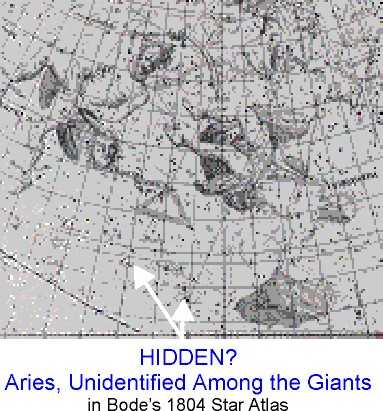
Aries (pronounced "AIR-eeez") is rather uninteresting naked eye constellation of fall skies. Like Andromeda, it is in that "quiet zone" that follows the spectacular summer Milky Way clouds and wealth of rich deep sky objects.....yet precedes the equally rich skies of winter, harboring the beautiful and bright constellations of Orion, Taurus, Cassiopeia and Canis Major. To me, Aries has always looked a bit like a ".....crooked dog's hind leg," which probably indicates something significant about my mental health.
Aries rises NORTHEAST for mid-northern latitudes about 9 p.m. local time on about August 16. High in the north, it takes a while to reach the meridian, or highest point in the sky, culminating at 4:15 a.m. on the following morning! However, midnight culmination - when it is on the meridian at midnight each year - occurs always on about October 20.
As with every "GO TO" TOUR guide, each GO TO object in Aries is discussed for your telescope regarding the type of conditions necessary for you to view it optimally for discern the very faintest details.........magnifications and aperture necessary for most objects, and much, much more. This is YOUR complete GUIDE to get you on your way to exploring the best (and few!) objects in this small constellation. The following listing of "BEST" objects contains the finest or most interesting from my own observing experience and preference.
Use the attached star chart and the following Guide as an excellent reference for your next star party itinerary, or a beginning for further study into the thousands of objects visible in this part of the sky. Truly these extensive Constellation Study Guides will most definitely put your AutoStar to work for you in the most efficient and enjoyable way possible! As a matter of fact, MANY AutoStar users are now programming their own "Tours" based on these guides, using each constellation as a separate GO TO Tour for the AutoStar library that can be added in or deleted through the main edit screen on your PC or MAC computer.
We hope you enjoy these comprehensive GUIDES to touring the constellations via your AutoStar and its computer-driven telescope. Each new installment is complete with diagrams, charts and illustrations that you will find nowhere else. Please let us hear YOUR feedback and your observations of each and every constellation after YOU have toured its vast reaches of our skies!
-----------------------------------
YOUR ARIES CONCISE DIRECTORY OF INTERESTING OBJECTS -
As mentioned, there is a void of interesting deep sky objects in Aries. So if you are a certified "galaxy hunter" or diffuse nebula groupie, this is not the constellation for you. However, if you enjoy beautiful and challenging double/multiple star observing, there are some wonderful targets for you in the Ram. For a full discussion on double star observing and their "Position Angles" refer to my brief overview in the "GO TO" TORU guide for Lacerta: http://www.weasner.com/etx/ref_guides/lacerta.html .
I have chosen the finest (or most interesting) 13 objects in this ARIES "GO TO" TOUR; as with all GUIDES, all objects listed below will be visible in most telescopes (some naked eye) from the ETX 60 through the LX 90; of course larger apertures may "show" an object a bit closer and "better," but frequently a wide field and low power view is more desirable than aperture for FINDING the objects initially. Indeed, I strongly encourage you first FIND the target object, or its approximate location through your GO TO function with your lowest power and then - once IDENTIFIED positively - move up slowly in steps with magnification if necessary. Remember, not all objects "like" magnification. Sometimes better "field of view" (such as the wonderful wide fields provided by the ETX 60 and 70) is desired over light gathering (like the big LX 90) and magnification.
The rule for determining "optimum magnification" is that: 1) too low power results in sky background glow detracting or diminishing the contrast against the deep sky object; 2) too high magnification darkens BOTH the sky background AND the object; 3) medium magnification can be achieved at which you have MAXIMUM contrast between the object and its darkened background sky. I have found through three decades of direct observing that about 15x per inch aperture (36x for the ETX 60/70; 55x for the ETX 90; 75x for the ETX 125; and, 125x for the LX 90).for deep sky observing is PERFECT for most objects. That being said, always remember that DOUBLE or multiple stars require whatever power you can crank out....the seeing conditions are the limiting factor here.
For my complete and comprehensive discussion regarding seeing conditions and sky transparency, see: http://www.weasner.com/etx/buyer-newuser-tips/seeing.html .
With all deep sky objects, avoid attempting to observe when the moon is in the sky, even a very thin crescent, as its brightness in the sky will overshadow the very dim contrast afforded by even the brightest deep sky object; if you see the object at all against moonlight, you will NOT see the subtle outlying areas or the full detail of what is presented.
For detail descriptive lists of the great double stars within Aries, and as with all of the "GO TO" TOUR constellation lists, I recommend a good star atlas and/or chart which will list all the finest objects, constellation-by-constellation. One very handy reference guide is the PETERSON FIELD GUIDE TO THE STARS AND PLANETS, which features complete lists with declinations, right ascensions, magnitudes, and all pertinent information for you to expand your observing horizons beyond this brief GUIDE. For the many double and multiple stars, refer to the indispensable "Burnham's Celestial Handbook", volume 1 for a complete abbreviated listing.
Note that your AutoStar may NOT have every object listed on every constellation GO TO tour....this is intentional. You can access some of the most interesting objects of the sky directly from their coordinates. It is quite simple as you merely enter these coordinates as follows in the 10-step process:
1) Press the "MODE" key and hold down for 3 seconds and release;
2) Displayed will be the current Right Ascension and Declination of the center of field of view of where your telescope is presently pointed (assuming that you have properly aligned from "home position");
3) [NOTE: if you have the Meade electric focuser attached to any of the ETX or LX telescopes, holding down the "MODE" key will bring up the "Focus" command first....merely scroll (lower right scroll key) down one step to access the RA and DEC to enter your desired coordinates]
4) Press the "GO TO" button on AutoStar;
5) This will change the display and you will note the cursor blinking over the first digit of RIGHT ASCENSION (R.A.); merely use the number keys and dial in the R.A. of the object you are searching for;
6) When done, press "Enter;"
7) This moves the blinking cursor over the "DEC" coordinates;
8) [NOTE: the declination, unlike R.A., can be either positive or negative and you will see the "+" or "-" sign displayed depending on where your telescope is aimed at that time; if it is NOT the desired setting (plus or minus), merely use your arrow key to move the blinking cursor OVER the "+" or "-" sign and change by using either of your lower corner SCROLL KEYS;
9) Proceed to enter the DEC using number keys;
10) Press either "Enter" or "Go To" when finished and the telescope begins slewing to your desired object!!
The constellation tour Star Chart above (click on and save to a file on your PC; then open it and re-size to fit the page and print for a very handy at-the-scope star chart) will get you started on your journey for this constellation.
Following is the concise object list for your "GO TO" TOUR of ARIES; you may wish to find many of the objects from the AutoStar Library (for example, you can easily go a fairly dim galaxy, NGC 772, if you pull up "Object/Deep Sky/NGC/..then type in '772'...." and then press "Enter", followed by "GO TO" to access this faint spiral galaxy. On the other hand, if you want to experiment and become a "better AutoStar user" try entering the exact R.A. and DEC coordinates of that object as described above after holding down the MODE key. You will find the accuracy of entered GO TO's to be somewhat less than those stored in AutoStar, but the capability of acquiring unlisted objects is fantastic!
You will access your FIRST GOTO target - (usually the brightest star in each constellation) - via the command "SETUP / OBJECT / STAR / NAMED....and scroll to "Hamal"", then press "Enter" and subsequently "GO TO" to move your this bright star.
You may also access the constellation by: SETUP/OBJECT/CONSTELLATION/Aries.....Enter....GO TO, which will subsequently take you to the brighter star Hamal, near the middle of the "crooked hind leg of the dog."
OBJECT 1:
brighter star HAMAL (alpha Arietis) - R.A. 02h 04' / DEC + 23 14 - Magnitude: 2.0
OBJECT 2:
bright double star - MESARTHIM (gamma Arietis) - R.A. 01h 51' / DEC + 19 03 - Mags: 4.5 & 4.5! Super!
OBJECT 3:
nice double - 30 Arietis - R.A. 02h 34' / DEC + 24 26 - Mags: 6 & 7 - VERY nice for all scopes - WIDE!
OBJECT 4:
runaway star - 53 Arietis - R.A. 03h 05' / DEC + 17 41 - The "runaway" star from the Orion Nebula!
OBJECT 5:
Struve 326 - R.A. 02h 53' / DEC + 26 40 - Mags: 7.5 & 9.5 - wonderful double, enough space for all!
OBJECT 6:
elliptical galaxy - ngc697 - R.A. 01h 49' / DEC + 22 06 - Mag. 12.2 - VERY faint, ETX 125 & up.
OBJECT 7:
faint spiral galaxy - ngc772 - R.A. 01h 57' / DEC + 18 46 - Mag. 10.8 - Visible as speck in ETX 90
OBJECT 8:
another faint spiral - ngc972 - R.A. 02h 31' / DEC + 29 06 - Mag: 12.5 - this one for the LX 90 only.
OBJECT 9:
irregular galaxy - ngc1156 - R.A. 02h 57' / DEC + 25 03 - Mag: 11.8 - faint, but visible in the ETX 125 +
OBJECT 10:
very nice variable star - R Arietis - R.A. 02h 13' / DEC + 24 50 - Mag: 7.3 to 13.8 in only 187 days!!
*** BONUS: ***
Your Aries List of VERY NICE DOUBLE STARS!! Here is a list of doubles in Aries, appearing in abbreviated form. On each of the following stars, you will find the following: A = star designation / B = R.A. / C = DEC / D = magnitudes of components / E = separation in arc seconds (") / F = minimum telescope required for resolution under BEST conditions / followed by any comments if needed! (these stars are in order of Right Ascension and DO NOT include those for the TOUR):
1. #1 Arietis - (B = 01 47) (C=+22 02) (D=6 & 7.5) (E=2.7") (F = ETX 90) Beautiful gold and blue!! 2. Struve 175 - (B = 01 48) (C=+20 52) (D=6 & 8.3) (E=23") (F = ETX 60) Tough to find, but worth the effort 3. lambda Arietis - (B = 01 55) (C=+23 20) (D=5.2 & 7.6) (E=37") (F = ETX 90) Nice and easy! 4. #11 Arietis - (B = 02 04) (C=+25 28) (D=6.4 & 12) (E=1.6") (F = ETX 125) Quite a test!! 5. Struve 226 - (B = 02 09) (C=+23 44) (D=8.1 & 10) (E=1.8") (F = ETX 90) Tough test. 6. Struve 43 - (B = 02 38) (C=+26 25) (D=7 & 8.6) (E=1.1") (F = ETX 125) Very tough even in LX 90. 7. mu Arietis - (B = 02 40) (C=+19 48) (D=6 & 12) (E=19") (F = ETX 125?) Doubtful except with 8" 8. pi Arietis (triple) (B = 02 47) (C=+17 15) (D=5, 8.5, 10) (E=3.2 & 25") (F = ETX 90) really neat!! 9. epsilon Arietis - (B = 02 56) (C=+21 08) (D=6 & 6) (E=1.4") (F = ETX 90?) great! Aligned nearly N-S!! 10. Struve 366 (triple) (B = 03 11) (C=+22 46) (D=7, 10, 10.5) (E=47, 1.7") (F = ETX 90) faint star is double.
---------------------------------
A VISUAL GUIDE TO OUR DEEP SKY OBJECTS IN ARIES
Object 1 - Our "Starting" Bright Star - "HAMAL" (alpha Arietis)
This star name demonstrates the common thread among ancient civilizations. When you consider so many celestial objects - the "lion" of Leo is a good example - that share the same connotation among the Chinese, the Egyptians, Arabs and other ancient historians, you must wonder how the "word spread" among these different corners of the world to hold such a similar attachment to mythology. The Arabic name for the brightest ("alpha") star in Aries is "Hamal", meaning the "sheep's head," a slight deviation from the later Greek reference for this star as a mighty Ram. Nonetheless, all seem to at least be swimming in the same waters regarding the overall "family" of animals! With an actual light/energy output some 70 times greater than our own sun, Hamal is a relatively close star, only 75 light years distant. Look for the distinctive "red-orange" color of this very late spectral type star.
Object 2 - "MESARTHIM" - (gamma Arietis) - One of the Most Popular Double Stars
This star has special meaning to old Doc Clay....it was the FIRST double star that I turned my brand new Unitron 4" refractor onto after it arrived on a brisk October night atop Cherry Hill in 1966. Prior to that night I had spent three years learning the entire sky and all the objects within the constellations with a pair of old 7 x 50 marine binoculars from my Grandfather's Chris Craft "marine vessel" as he coined it.
This is an absolutely beautiful double star and one very easy for all telescopes in all sizes. The components are too bright an close to miss! Both are almost identical in brightness (4.7) and color (brilliant white). Even at low powers the stars are easy to split because of the wide 7.8" arc separation; the color is best appreciated at about 15x per inch aperture of your telescope, which also provides a very pretty star field around this pair as well. The slightly fainter star is in Position Angle 48 degrees, or almost due NE from the brighter star.
Object 3 - 30 Arietis - A very nice and easy double star for all scopes
At a distance of only 190 light years, this is a wonderful double star for common telescopes. The brighter star is distinctly yellow in medium magnifications at magnitude 6.6, while there is a noticeable "blue" tinge to the fainter (magnitude 7.4) star which is nearly due WEST (Position Angle 274 degrees) of the brighter one. The separation of nearly 40" arc makes this a prime candidate for smaller instruments!
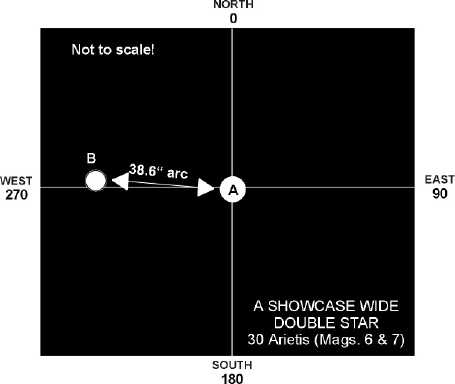
Object 4 - "The Runaway Star" - 53 Arietis.
One of three such stars that appear - if you back-trace their pathways from their current large proper motions through the sky - to have been "ejected" from the region of the Orion Nebula! Of the hundreds of known stars that are associated with the nebula, and likely FORMED from it, these three somehow "got away" and exhibit extremely high velocities in space, with 53 Arietis moving at an incredible clip of 35 miles per second....thirty five times faster than the X-15 Rocket Plane of the U.S. Air Force!
If we backtrack from where these objects are today....and factor in the speed at which they are moving....then astronomers can calculate that they "left" or were pushed out of the Orion Nebula about five (5) million years ago - just yesterday in the cosmic scheme of things.
53 Arietis is magnitude 6.0, easily visible in all of our telescopes provided you know WHICH star you are needed to focus in on. Use my star chart below (adapted from the A.A.V.S.O. variable star charts) to help acquire the actual field of view of this star. You should notice that - just like the very hot, young stars of the Orion nebula - this star appears brilliant white. The other two "runaway stars" are AE Aquarii and Mu Columbae (southern skies), and all three are erratic variable stars.
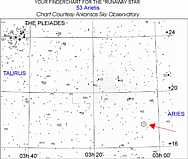
Object 5 - Struve 326 - A Fine Red Dwarf Double Star
Both of these stars are smaller than our own sun and very close to our neighborhood, at 55 light years distant. The colors of the stars (crimson red) are very distinctive in the ETX 90 and above with powers of 100x or greater. This should be a relatively easy split for even the ETX 60/70 with a separation of about 6.5" arc. The brighter star is magnitude 7.5 while the fainter one comes in at a rather dime 9.5, just west of due south from the primary star (Position Angle 219 degrees). Although the star should be rather easy in the ETX 90, the chart below will assist in locating the fainter star relative to its fairly bright partner.
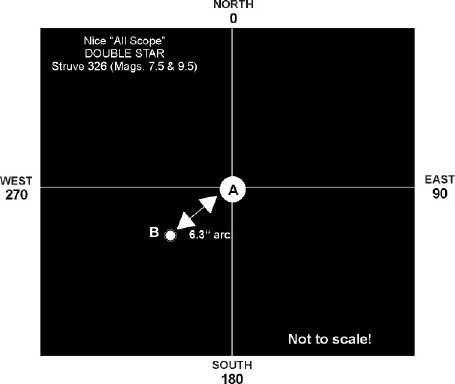
Object 6 - A very faint elliptical galaxy - NGC 697
This will be a challenge for the ETX 125 and likely NOT seen except as perhaps a very faint starlike object some 2' arc across, like an out-of-focus star. The LX 90 will show it a bit better and clearly differentiate its nature from that of a star. This elliptical galaxy is oblong (2' x 1' arc) and only magnitude 11.8, thus is right at the "extended object" magnitude limit for the ETX 125, and close for the 8" scope. Forget this one with smaller instruments.
Object 7 - A faint spiral galaxy - NGC 772
Here is another faint galaxy for the strong at heart. Its magnitude 10.8 is deceiving....this galaxy is only 5 x 3' arc across and very difficult to find. It should be relatively easy if your skies are very dark with the ETX 125, but do not expect much detail on this object at all. This is what we call "grabbing at straws" for GO TO objects....remember we are in a zone of "nothing" in the way of deep sky objects here. In the LX 90, there may be a HINT of a very large "lobster claw" spiral arm to the northwest of center....use about 225x to get the best chance of seeing this appendage.
Object 8 - Another faint spiral galaxy - NGC 972 - Blotchy at Best!

You can be the judge on this one, based on the photograph shown above from the Palomar 200" telescope. Is this a true "spiral galaxy" or perhaps an "irregular?" I can clearly see the indication of spiral structure, but this is truly a galaxy in turmoil. This object will ONLY be visible in the LX 90, at magnitude 12.5. It will appear extremely tiny, like a fuzzy star right at the threshold of visibility. Use very high power (as much as the object will hold before becoming too faint to see) and you might see a bit of mottling within this tiny object.
Object 9 - An irregular galaxy for the books - NGC 1156
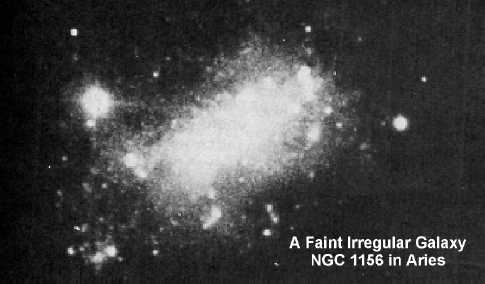
Another VERY faint galaxy, but an interesting irregular one that shows much chaotic structure as can be seen in the Palomar Observatory photograph above. This galaxy, like all in Aries, is just on the verge of visibility in the LX 90 and users of smaller instruments need not waste their time....find a good double star to play with. There is really nothing interesting to see with this object, even in the largest of all amateur telescopes.
Object 10 - A Very Nice Variable Star - R Arietis R Arietis is classified as a long-period variable star, but it has a wonderfully "short" period in spite of it - only 187 days! During that period, the star will brighten to magnitude 7.3 or thereabouts and subsequently dim again to about magnitude 13.8 and eventually back to brightest again! This cycle can be completely monitored with the ETX 90 and larger scopes provided that the user locates and identifies correctly the right star. This is where the American Association of Variable Star Observers (AAVSO) star charts come in. Free for the downloading, you may download to file the FINDER "b" wide field chart at: charts.aavso.org/STANDARD/ARI/R_ARI/RARI-BR.GIF which will give nice reference magnitude comparison stars for when R Arietis is at its brightest. As it begins to fade fainter and fainter, move up in magnification to allocate even fainter stars through the AAVSO chart charts.aavso.org/STANDARD/ARI/R_ARI/RARI-DR.GIF which shows stars to less than magnitude 14 (far beyond the reach of nearly all scopes) for comparing the star as it plummets in brightness. Note that BOTH of these nice charts are "REVERSED" charts, meaning that they have been constructed to match the view of a Maksutov or Schmidt Cassegrain telescope with the diagonal mirror in place (north at top and EAST to the right).
Merely download each chart and assign a file name; bring up that file and resize the image (it will be quite large) to fit the page and "save." Then bring that re-sized file back up and print it! You now have two wonderful star charts to devote many nights observing this wonderful star. I recommend observing the star about once per week but really not more often, as daily observations (as you might do with an irregular or eruptive star) are overkill with little or no change seen from one day to the next. Log your estimates, plot the on your own graph paper and see what YOU come out with! And by all means e-mail your results on a monthly basis to: www.aavso.org so that your observations can contribute the scientific body of knowledge for this star!
----------------------------------
WANDERING ABOUT....YOUR NEW "USER OBJECT" IN ARIES
Red dwarfs, white dwarfs, neutron stars, black holes, X-ray sources, red giants....sounds like a ZOO! So why not add a "runaway object" to your "GO TO" GUIDE of user objects in your Autostar library?! Not only is 53 Arietis one of only three such known stars to be "expelled" from the Orion nebula and flying through space, but it also is a moderate variable star as well! It varies from magnitude 6.1 to 6.3 (not really enough to monitor with the human eye) in addition to its antics as it moves freely through space!
On AutoStar, go to: "Select/Object [enter]...." scroll down to "User Object" [ enter]. Now enter the coordinates given above for "runaway", using the number keys on AutoStar. After entering the coordinates and pressing "Enter" yet again, scroll down one and you can list the magnitude of the object as "6"[Enter].
Now you have yet another unique and oft-overlooked deep sky object for conversation-starters and crowd-stoppers at your next star party or club outing.
Next Constellation GO TO" TOUR Installment: CETUS, yet another constellation from the watery depths of the celestial rivers and oceans! This great Sea Monster / Whale (depending on which dramatic school of thought you follow) is one of Ptolemy's ORIGINAL 48 constellations from 2 A.D. from the 1022 brightest stars of the sky. It has remained virtually unchanged since his inception over 2000 years ago.
Good Observing and may the stars serve as your sentries as you explore the frontiers of space!
P. Clay Sherrod
Arkansas Sky Observatory
Conway / Petit Jean Mountain
Arkansas
Return to the top of this page.
Go back to the Observational Guides & References page.
Go back to my ETX Home Page.